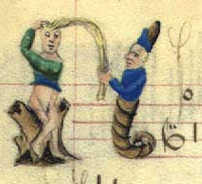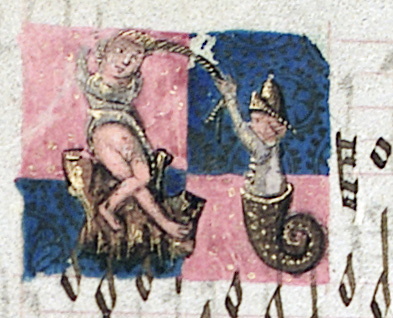Copenhagen
Copenhagen, The Royal Library, MS Thott 291 8° (Copenhagen Chansonnier)
Facsimile – at http://www.kb.dk/permalink/2006/manus/702/eng/.
Modern editions – in Jeppesen 1927; and online at the present site; a different online edition by Clemens Goldberg (2011) is found at the Goldberg Stiftung.
Scholarly literature (selection) – Jeppesen 1927; Thibault 1927; Gutiérrez-Denhoff 1985; Higgins 1987; Alden 1999; Alden 2010 - especially the very detailed description in Appendix A (A3- PDF).
Description
Small parchment chansonnier, c. 17 x 12 cm, 49 folios (of original 56) and 2 flyleaves glued to the binding, original binding of violet velvet on wooden boards, edges of the leaves were gilded as part of the binding, 7 fascicles, modern foliation starting at the second folio (f. 1), (1) pages ruled in red ink with 7 staves per page, music and texts in black ink, decorated initials. Fasc. 7 – containing the extra empty pages for new compositions – is ruled in a slightly different way.
The original contents were 36 chansons (3 have disappeared), all copied without any composer ascriptions by the main scribe who is identical with the main scribe of the Dijon chansonnier (the Dijon scribe). Fascicle 7 contains later additions.
Fascicle structure (see also the extended List of contents) – seven fascicles (gatherings), originally all of four bifolios (quaternions):
Fasc. 1, ff. 0-7v.
Fasc. 2, ff. 8-15v.
Fasc. 3, ff. 16-23v.
Fasc. 4, ff. 24-27v – 2 bifolios are missing. This causes disruptions between ff. 24v and 25, and between ff. 26v and 27, leaving four chansons incomplete (nos. 19-22), and two have disappeared.
Fasc. 5, ff. 28-33v – 1 bifolio is missing between ff. 30v and 31 causing two chansons to be incomplete (nos. 25-26), and one has disappeared.
Fasc. 6, ff. 34-41v.
Fasc. 7, ff. 42-47v – 1 bifolio was used for flyleaves first and last in the MS.
Decoration
All pages copied by the Dijon scribe have decorated initials. The initials are formed by grotesque figures, which all were designed with the help of the same pattern book. One sheet was decorated by a different painter in the workshop (consisting of ff. 1 and 6). He used a yellow rectangle as background for the figures, while the main painter made the figures freestanding (see the facsimiles).
The Wolfenbüttel chansonnier was decorated with similar initials in the same workshop, or in a workshop using the same or a similar pattern book. See for example the letter “N” used in both sources at the beginning of »N’aray je jamais mieulx que j'ay« by Robert Morton (see Figure 1, other letters using similar patterns are, “A”, “J”, or “L”, and “T” found on Copenhagen ff. 10v, 22v, 16v, and 34 – and Wolfenbüttel ff. 16v, 5v, 55v, and 2 respectively); the initial in Wolfenbüttel is the only one using a coloured background, all the rest are freestanding. It is also the only one showing a person with a naked lower part of the body; there are plenty of nudes, but only one with a covered upper body. This type was, however, popular with the decorator of the Copenhagen chansonnier, cf. ff. 5v, 6v, and 35v.
 |
 |
Figure 1, Copenhagen f. 2v and Wolfenbüttel f. 6bisv
Genesis
Made by the Dijon scribe for a customer. His work on the small chansonnier was probably finished after some weeks if he was able to use exemplars already in his possession. The uncut sheets were then sent to a painter's workshop for decoration, and then returned to the scribe for the addition of the fascicle containing empty staves, the binding and delivery.
The addition of Claudin de Sermisy's three-part setting of Clément Marot's “J'actens secours" (no. 34, Hand CopenhagenB) shows that the owner of the MS was in the environs of the royal court during the period 1515-c. 1520 – the song was composed c. 1515-1518 (see further Christoffersen 1994, Vol. 1, pp. 246-248; incl. edition).
The next pieces (no. 35, Hand CopenhagenC) were added later in the 16th century. They consist of four-part settings of the eight psalm tunes, litanies and a “De profundis” in strict note-against-note texture.
The MS does not disclose any information concerning its original owner. On f. 46 we find a row of inscriptions in three different sixteenth-century hands: “Ex libris Johannis du Moulin / Dono domini Decani”; “pãr. hue. [?] huc a Joanne du moulin iterato dono suscipere / digneris”; and “ex dono domini du moulin / olivario le Crec abbate de Joyaco.” This may mean that the MS was in the possession of the humanist Guillaume Hué (d. 1522) from Orléans, from 1518 dean of the cathedral of Paris. (2) From him the MS may have passed to Johannes du Moulin (d. 1563). canon, singer, and maître des enfants at Sens Cathedral. Olivier le Crec (d. 1582) was abbot of the Cistercian abbey Jouy-le-Chatel, in Seine-et-Marne.
For detailed information on the copying, decoration, further inscriptions and later provenance, see Alden 2010, Appendix A3.
Dating and relative dating
1473-1474. This dating is based on the analysis by Jane Alden who finds that Copenhagen is the latest preserved result of the Dijon scribe's work, and that his hand exhibits changes developed over a period since his earliest preserved work on the Dijon chansonnier (see further the description).
Datings in the musicological literature: Jeppesen 1927, 1470-1480; Perkins 1979, 1470s; Gutiérrez-Denhoff 1985, c. 1465-1475; Alden 2010, 1470s.
1) The foliation postdates Jeppesen’s edition; one must be subtracted from his folio-numbers to bring them in line with the actual foliation.
2) Peter G. Bietenholz & Thomas Brian Deutscher, Contemporaries of Erasmus: A Biographical Register of the Renaissance and Reformation, Vols. 1–3, University of Toronto Press, 2003, vol. I, pp. 211-212.